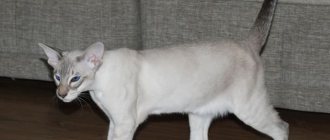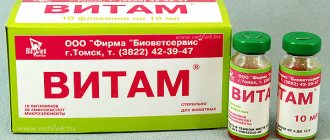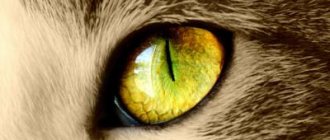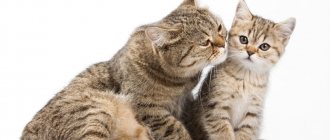One of the most severe birth complications is uterine prolapse in cats. The pathology has 2 types and is accompanied by bleeding, the appearance of an organ from the pelvic area, and a general deterioration in the pet’s well-being. If a condition occurs, the owner should know how to provide first aid and take the cat to a veterinary clinic, where a specialist will prescribe treatment.
According to veterinarians, animals with a loose constitution are at risk of uterine prolapse, and the pathological condition itself develops 5-6 hours after labor.
Causes of inflammation of the uterus
Today, veterinarians have found that the disease is provoked mainly by the following reasons:
- hormonal imbalances, after which endometritis was not fully treated;
- inflammatory pathologies of the urinary system that have not been properly and completely treated;
- giving the animal hormonal drugs to prevent estrus and pregnancy;
- violation of sanitary rules at the time of mating of an animal, when a cat and a cat are brought together that has not been examined for various bacterial infections of the reproductive system;
- unsanitary conditions in the place for childbirth, due to which dirt and pathogenic bacteria are introduced into the birth canal and uterine cavity;
- the remains of the placenta that did not come out after the birth of the kittens - suppuration in such a situation develops within a few days after lambing;
- pathologies in the structure of the reproductive system, in which an open cervix provides bacteria with free access to the inside of the organ.
Uterine prolapse
This pathology manifests itself in the first postpartum hours. Loss can be of 2 types: complete or incomplete. Its possible reasons:
- uterine atony;
- large fruits;
- forcible removal of kittens;
- excessive effect of tonic drugs;
- ruptures and weakening of the ligamentous apparatus, etc.
The mucous membranes of the prolapsed organ gradually dry out and then die. There may also be ruptures and wounds on the uterus.
A newly prolapsed and intact uterus can be reset. This process is carried out by a veterinarian. Before repositioning, the genitals are irrigated with cold disinfectant solutions and dried with sterile wipes. Antiseptic ointment is also applied to them. Antibiotics are administered intravenously, a loop-shaped suture is made on the vulva, and a sacral blockade is made.
Symptoms
The disease has 3 forms. The greatest danger of them is the hidden one, due to which the animal’s condition deteriorates very slowly, and symptoms appear only at the last moment, when the uterus is close to rupture, and it is almost impossible to help the pet.
Another form of inflammation, in which the cat’s uterus has an open cervix, is not so dangerous, since it cannot lead to the death of the animal in 1-2 days. However, this does not mean that the cat can do without therapy. If the animal's condition is left unattended, its death will occur within 1-2 weeks. Only sometimes there are cases when a very strong cat can live up to 3 weeks. With this pathology, the animal experiences the following symptoms of uterine inflammation:
- discharge of pus from the genital fissure (vagina);
- the cat licks the external genital area excessively;
- dark brownish spots where the cat sleeps;
- complete loss of appetite;
- elevated temperature;
- The cat drinks a large amount of liquid.
Every day the pet's condition worsens. The volume of purulent discharge increases, the uterus constantly pours out pus, and the cat no longer has time to wash it off, which makes it noticeable not only on the bedding, but also on the fur around the genital opening.
Types of complications
After a successful birth, the veterinarian gives a special injection with a hormonal drug - oxytocin. This is necessary in order to stimulate the involution of the uterus (returning the organ to its original pre-pregnancy size), as well as stimulate milk production. It is also necessary to conduct research on milk to avoid various infectious diseases.
For the first 7 days after the animal lambs, it is necessary to constantly monitor body temperature, taking measurements at least once a day. When the temperature rises above 39.6 degrees, you need to sound the alarm. Purulent discharge that lasts more than 2 weeks indicates a serious and dangerous pathological process.
Complications after childbirth include a whole list of pathological conditions:
- acute and congestive mastitis;
- bleeding from the uterine cavity;
- subinvolution of the uterus;
- inversion and prolapse of the uterus;
- eclampsia;
- acute metritis.
Metritis
Metritis is an inflammatory process on the uterine mucosa that occurs due to infection of the birth canal by foreign bacterial pathogens. The onset of the disease can occur immediately after childbirth, or some time after.
READ What do wild boars eat in winter?
Causes
The main factors in the development of acute metritis are delayed delivery of the placenta. The cause of inflammation of the uterine mucosa is the delay of the last dead kitten, which can mummify in the cavity of the reproductive organ. The infection can also penetrate the birth canal if the rules of asepsis and antisepsis are not followed. Obstetric care provided at home with unsterile instruments or dirty hands can provoke the development of infection.
Another common cause of inflammation of the uterus and uterine walls is failure to maintain cleanliness in the nest with kittens, both during the birth process and after it. In order to prevent this postpartum complication, it is recommended to remove blood and placenta, which can serve as an excellent breeding ground for the growth and reproduction of bacterial microorganisms.
Symptoms
The animal looks depressed and lethargic. Body temperatures begin to vary from 39 to 40.7 degrees. The animal has no appetite and shows complete apathy towards what is happening. Such a cat does not lick her kittens and does not monitor their hygiene. The milk produced in the mammary glands of such an animal is not suitable for feeding offspring.
Normal physiological secretions pass without changes in body temperature, diarrhea, eruptions of gastric contents and other characteristic signs of poisoning of the body with products of the vital activity of pathogenic microflora.
Therapy
Treatment of postpartum complications includes proper care of the animal. Kittens must be weaned from their mother and fed with artificial formula. A course of antibiotic therapy is prescribed using broad-spectrum antimicrobial agents of the cephalosporin group. If there is no success, surgical intervention may be prescribed - excision of the inflamed uterus and appendages.
This type of pathology is quite rare in the cat family. Eclampsia, or milk fever, occurs both during childbirth and some time after. This complication is mainly diagnosed during lactation from 18 days to 18 weeks.
Causes
The main reason for the development of pathology is calcium deficiency in the body. Calcium plays one of the leading roles in the passage of signals through the nerve fiber system. The period of gestation of kittens and lactation is marked by a large amount of calcium circulating in the bloodstream, used for the development of fetuses and milk production.
Symptoms
Quite often, milk tetany occurs in cats with large litters. The onset of pathology occurs during childbirth. So, the animal gives birth to the first kitten and sleeps for several hours before the next one comes out. If the fetus does not match the size or is in the wrong position, stimulation with oxytocin or other auxiliary medications is not carried out due to the possible threat of uterine rupture.
READ Does oncology occur in cats? Causes, types and treatment of the disease
The main symptoms of postpartum eclampsia:
- animal anxiety;
- rapid breathing;
- pallor of the mucous membranes;
- impaired coordination of movements;
- convulsive trembling of the fore and hind limbs;
- sharpening of the muzzle due to tightening of the skin.
12 hours after the appearance of characteristic signs, the animal may die as a result of increased temperature and damage to the meninges.
Treatment
You can avoid death if you promptly seek qualified veterinary help. The basis of treatment for eclampsia is injections of calcium digluconate to restore the balance of the mineral in the body. If the animal's body temperature is elevated, manipulations are performed similar to those of a heatstroke. It is important to add portions of vitamin D, phosphorus and calcium to your cat’s diet.
One of the common complications of childbirth in firstborns is uterine prolapse. First aid should be provided to the animal immediately, as infection of the internal organ and the appearance of secondary complications are possible.
Causes
The basic reasons for the development of this pathological change in the animal’s body are the following factors:
- violation of contractile function of the uterus;
- a large number of fruits;
- large kittens;
- strong attempts;
- improper obstetric care;
- polyhydramnios;
- disturbances in the functioning of the ligamentous apparatus of the pelvic organs;
- long-term use of specific tonic medications.
In addition to the main factors, there are also secondary ones - the factor of genetic heredity, disruption of the cat’s activity in movements during the process of bearing fruit, disturbances in the correctness and balance of the cat’s nutrition. Experts in the field of veterinary medicine believe that uterine prolapse most often occurs in cats that have a fairly loose constitution of the body and those animals that are weakened.
Symptoms of pathology
The main symptom is the prolapse of the reproductive organ from the physiological opening.
Other signs are:
- the appearance of a pear-shaped formation from the vagina;
- swelling of prolapsed tissue structures;
- bleeding;
- the presence of cracks on the surface - when the mucous membrane dries out;
- swelling and swelling in the vaginal area;
- sudden refusal to eat;
- depressed state of the animal;
- pallor of visible mucous membranes;
- violation of the act of urination and defecation.
READ Caracal desert lynx: description and photo of the breed, maintenance and care at home, where to buy a steppe cat
Treatment
Treatment involves repositioning the reproductive organ in a veterinary clinic by a qualified specialist. Before moving the uterus into place, the mucous membrane is irrigated with a cool solution of alum or furatsilin. After drying with special tampons and lubricating the mucous membrane with antimicrobial ointments, the organ is set by hand.
To prevent re-loss and securely fix the reproductive organ in the cavity, loop-shaped sutures are applied. In some cases, the laparoscopy method is used, and the reduced uterus is sutured to the abdominal wall. After prolapse and inversion of the uterus, complications in the form of endometritis often occur.
Uterine hernia
When a cat has an organ hernia, palpation reveals a soft round protrusion in the perineum or below the inguinal fold. When pressed, it goes into the abdominal cavity. During pregnancy, swelling increases simultaneously with the growth of the fetus. With this injury, possible strangulation of the uterus, embryos, compression of the rectum, ureters, and vagina.
We suggest you read: Personality of Maine Coon cats What to expect from a large and menacing-looking pet
The only way to cure a cat is through surgery. First, the doctor moves the uterus and its contents into the abdominal cavity. In case of necrosis, adhesions, or death of unborn kittens, the uterus is amputated.
Photo of pyometra in a cat
Read here Constipation in cats: main causes, first symptoms, types of disease and treatment of constipation (110 photos)
Help the site, share with friends 
Drug therapy
Treatment with medications can only be used at the very beginning of the disease and if the uterus has an open cervix. The result of such therapy is positive only in 15% of cases. Because of this, inflammation is not often treated in this way. The main medications that the cat receives in this case are the following:
- Oxytocin - the drug provokes uterine contractions, which clears the uterus of purulent contents. The drug is used with extreme caution, since even a slight excess of the dosage based on the cat’s weight leads to the uterus rupturing and the cat dying;
- amoxicillin is a broad-spectrum antibiotic that is effective against most pathogenic bacteria that the uterus may contain;
- Ceftriaxone is also a broad-spectrum antibiotic that is effective against major pathogens. In some cases it can be used with other antibiotics, but not often. The dosage is determined by the veterinarian depending on the condition of the cat and its weight;
- immunomodulators – are prescribed without fail to strengthen the animal’s body’s resistance and increase local immunity;
- Iron supplements are indicated to improve the cat’s blood composition and general strengthening. Appointed at the discretion of the veterinarian.
If after 1-3 days of drug treatment the uterus remains inflamed and the cat’s condition does not improve, urgent surgery is necessary. Treatment of uterine inflammation with medications is not recommended at all, and therefore, if pathology is detected, the cat must be urgently sterilized.
Diagnostics in a clinical setting
To accurately determine the type of disease, the following diagnostics in a clinical setting are indicated:
- A blood test is performed. Usually it is not so important for making a diagnosis, but the number of leukocytes and erythrocyte sedimentation rate (ESR) can be used to judge the severity of the inflammatory process.
- It is very important to conduct ultrasound and x-ray examinations, since these techniques allow you to visually assess the size of the uterus, the thickness of its walls and obtain other important information.
- It is mandatory to take exudate samples and conduct a microscopic examination of it.
- Exudate samples are inoculated onto nutrient media. This way you can determine exactly which microorganism caused the development of the inflammatory process. Having ready-made cultures on hand can also determine which antibiotic will be most effective in treatment.
- A vaginal examination is performed. So, in particular, it is possible to determine not only the degree of opening of the uterus, but also to differentiate endometritis from severe cases of vaginitis.
Possibility of using traditional anti-inflammatory drugs
It is not permissible to self-medicate with various home remedies if the cat is suffering from an inflamed uterus. They are not able to restore health to the pet and the disease will lead to death, since the animal will not receive the necessary treatment. Even if one of the home remedies brings temporary relief to the cat for a couple of days, it will not cure it, and during this time the uterus may become overfilled with pus.
We invite you to familiarize yourself with: Character and distinctive features of the Burmese cat breed
How to help?
When uterine prolapse occurs in dogs, what should owners do? Provide your pet with the necessary assistance before the veterinarian arrives.
The female is placed on her side so that her butt is slightly raised. The uterus should be wrapped in a clean cloth. This is done in order to prevent contamination of the organ and, as a result, the occurrence of cracks. If dirt gets on the fallen part, it is carefully removed with a damp cotton swab.
Prevention of uterine inflammation
The only way to prevent the occurrence of the disease 100% is by sterilizing the cat, which involves the entire uterus. If a cat is started for breeding, in order to prevent it from developing a disease, the necessary sanitary conditions must be provided at the time of mating. The same applies to the moment of birth, as well as the first week after lambing, while the cervix is not yet completely closed and the cat is especially vulnerable.
The most important thing is that a cat whose uterus is inflamed receives help as soon as possible, since if not treated in a timely manner, the disease leads to the death of the animal. Therefore, if a cat is owned, the owner is advised to consider the possibility of sterilizing the animal for preventive purposes.











